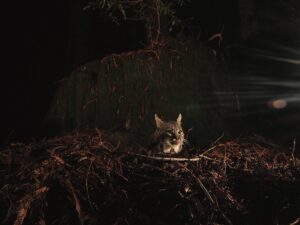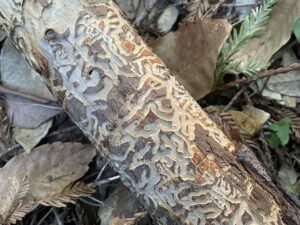
Ted and Moorea Stout follow an old logging road that passes their house, walking through charred groves of century-old pines and burned California black oaks flaunting vibrant new foliage. Ted veers into the forest, striding to an 18-inch stalk with dark green leaves whorled around a single stem. He bends to greet three buds swelling out of trumpet-shaped pods, all but caressing them.
“Washington lilies!” he exclaims, his broad grin radiating delight. Within a week the buds will burst into elegant white blossoms wafting their spicy fragrance into these woods.
It is a bittersweet moment for the Stouts. Spring has arrived with paintbrush and big-leafed maples sprouting among the blackened trunks of Douglas fir, and sugar and ponderosa pines. The early June sun filters through needleless branches, sending stark shadows onto the moon-shaped leaves of miner’s lettuce. Nurturing these 219 acres, at the northern end of the Sierra Nevada in Indian Valley, was the Stouts’ motivation for leaving their jobs in Southern California.
“We wanted to be good stewards to a tiny corner of the world where we felt a deep and profound connection,” says Moorea, who previously owned a kitchen and bath design company.
When they purchased the land adjacent to the Plumas National Forest in 2015, they quickly began work on a comprehensive plan to manage their forest, which grows over tunnels where gold miners struck it rich in the late 1800s. The land had seen scant activity in 30 years, and saplings had grown so dense in places a person couldn’t walk between them. The Stouts developed a timber harvest plan, mandatory under the California Forest Practices Act, working with a licensed professional forester who designed a strategy to remove smaller trees, harvesting only those that would contribute to the overall resilience of the stand. J&C Enterprises, a local state-licensed logger, would cut the trees and sell them to a local sawmill to partially offset the costs of removal. As required by state law, the plan protected streams and moist drainages, especially where tiger lilies grow, from logging and all equipment. It prioritized the large old trees, generally more resistant to wildfire than younger trees with thinner bark, scientists say. With brush and small saplings removed, the Stouts could then safely burn around the old trees, returning fire to this ecosystem where it had previously existed for millennia. Natural resource specialists and an archaeologist vetted and approved the management plan. The Stouts’ goal was a forest where fire could move through and benefit plants and wildlife on their property.
The logging was never about money, says Ted, a software programmer. “We were committed to taking care of this land.”
They were ready to implement their plan in early 2021 when it all collapsed: They learned that the sawmill company would not buy their trees due to a glut. The previous year the North Complex Fire burned 319,000 acres, which included huge swaths of industrial timberlands owned by Sierra Pacific Industries, one of the commercial sawmills the Stouts hoped would buy their logs. The sawmill yard, in nearby Quincy, was filled with three-story-high, careening stacks of charred-bark logs. Faced with a multiyear supply of logs, the sawmill owners took a hiatus—they would not buy most logs until wood salvaged from their own burned lands became too degraded to be of value. The Stouts were crushed. Without a place to haul and mill their trees into usable lumber, they left them standing surrounded by brush. Cutting and leaving them on the ground would only increase the fire danger.
But the cruelest blow came with the 2021 Dixie Fire, sparked by faulty Pacific Gas and Electric Company equipment on the same power network that started the 2018 Camp Fire. It raced through their forest and countless others, all densely packed with trees tinder-dry after multiple years of drought. The largest single fire in California’s recorded history, the Dixie Fire roared for more than three months through nearly one million acres, from the Feather River Canyon to Lassen Volcanic National Park, creating its own weather in firestorms of torched trees and burning embers that flew miles through the pyre-baked air. When a pyrocumulus cloud collapsed on the mountain above Greenville—just five miles from the Stouts—it took about 30 minutes for fire to reduce the town’s tarnished Gold Rush charm to molten ash. The timber burned in the Dixie Fire contained as much lumber as California can produce annually. Ted and Moorea Stout lost 80 percent of their forest: the smaller trees—the very ones they were trying to remove to reduce the threat of fire—and the old trees they were trying to protect. In places the soil was so scorched it will not hold the water new plants need.
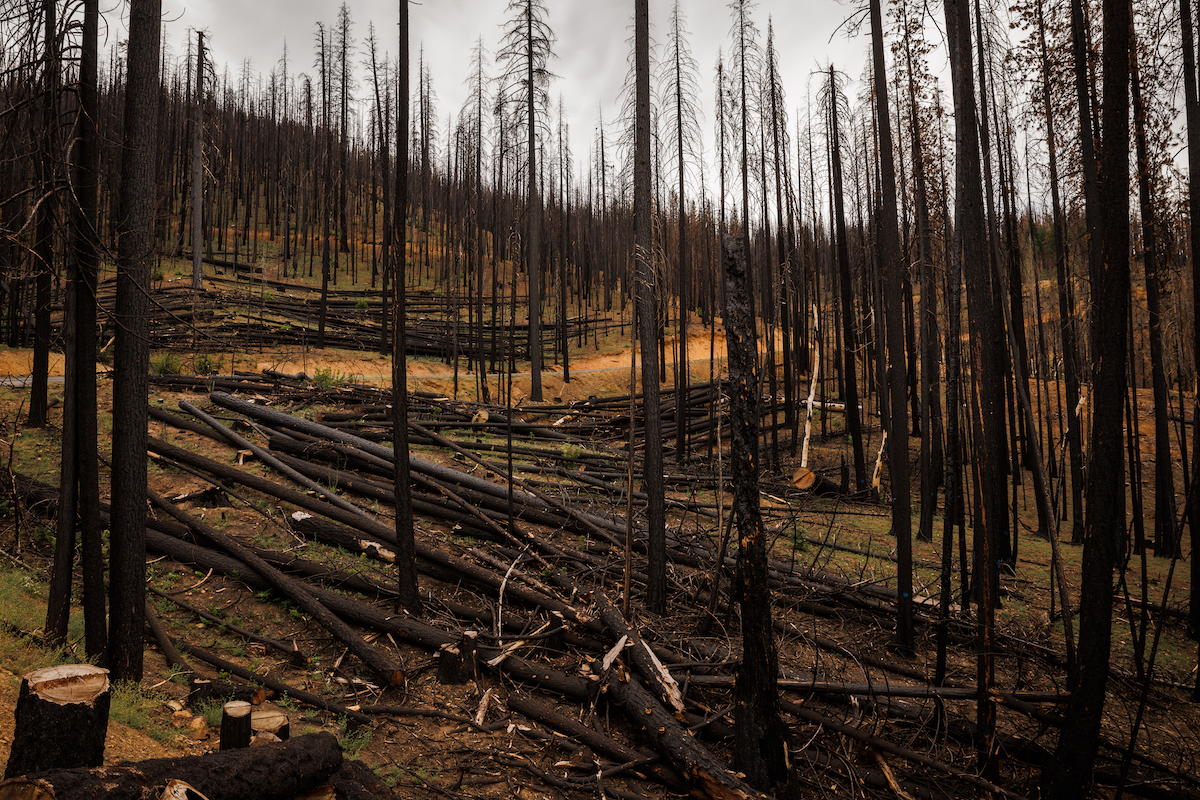
The Stouts are among the 202,000 individual owners of private forests stretching across nine million acres in California. Nearly 90 percent of these owners possess less than 50 acres of land. Combined with stands owned by Sierra Pacific, Collins Pine, and other timber corporations, 40 percent of California’s forests are in private ownership. More than half the forests classified as high wildfire risk are privately owned. And they are burning, sending smoke into the Sacramento Valley, the Bay Area, and throughout the West in a cascade of effects contributing to climate change. Of the 4.3 million acres burned in 2020, around 40 percent were privately owned. Most of these owners of forests over 10 acres in size are like the Stouts: they want their forests to be resilient and are willing to undertake the management to accomplish that. Their number-one priority is reducing fire hazards, according to a federal survey.
More than half the forests classified as high wildfire risk are privately owned. And they are burning.
In forests across the West, conditions have deteriorated dramatically over the last 30 years, causing a greater percentage of high-severity fires over a larger area. With 150 million trees killed, mostly by drought and bark beetles, in California alone, and with seven of the state’s largest fires in its history occurring in the last five years, scientists and agency officials are calling for active forest management: more prescribed burning and much more aggressive forest thinning (removal of trees). Scott Stephens, a professor of fire science at University of California, Berkeley, is among them. “The forests of the western United States are facing an unprecedented crisis, besieged by wildfires and climate change,” Stephens and others said in a recent Los Angeles Times op-ed.
The public is increasingly adopting intentional burning as a forest management tool and returning natural fire to the landscape for its rush of nutrients and the suite of fire-adapted species it supports. To some, however, thinning is just another word for harmful logging, and using chain saws to remove brush and small trees will make fires spread faster and more intensely, they contend. It is a controversial position that has attracted public attention as well as scientific scorn. The majority of fire scientists cite evidence of unnatural crowding in forests. Stephens and other scientists documented as much as a sevenfold increase in tree density between 1911 and 2011. For forests to be resilient to fire and drought, managers may need to reduce the number of trees per acre by up to 90 percent, they found. Other scientific studies cite the critical importance of both burning and thinning to make forests more resilient to climate-driven fire and drought.
The sheer number of forest fires and the growing intensity from unnaturally stocked forests demands decisive action, says Stephens. Climate change is up to 25 percent of the problem in forests adapted to frequent fire; “the rest is forest management,” he wrote in an email.
Ben Blom, director of stewardship and restoration for Save the Redwoods League, an environmental nonprofit, has witnessed the results of hands-off forest management. That model isn’t working anymore—not in today’s climate conditions, he says. In the last five years, approximately 20 percent of all the giant sequoia trees in the world have been killed in wildfires. That’s unprecedented, Blom says. “These are not static ecosystems and the decisions we make or don’t make now will have repercussions for the long-term health—and even the long-term existence—of our forests,” he adds. “Sometimes the best approach requires using a chain saw. Sometimes it requires using a drip torch.”
Yet even logging practices backed by a majority of ecologists and fire scientists can be abused. Landowners must comply with regulations designed to safeguard forest ecosystems and watersheds, says Ariel Roughton, manager of UC’s Berkeley Forests research properties. The foresters drawing up timber harvest plans must be registered professionals licensed by the California Board of Forestry and Fire Protection, which is responsible for developing state forestry policy. Loggers are also state licensed. Cal Fire is responsible for enforcing laws related to logging on private lands. Before, during, and after logging, Cal Fire inspectors visit the site and evaluate the operation to ensure compliance with the harvest plan and the law. Violations can result in citations and culminate in license revocation for both foresters and loggers. Still, Roughton says, the system isn’t always perfect. Most operators are reputable but even licensed loggers can take advantage of landowners who are not fully aware of the pertinent laws and their potential obligations, she told me.
“They have work lined up from now until whenever.”
—George Gentry, senior vice president of the California Forestry Association, on finding licensed loggers
The call for active forest management faces many challenges, and it comes at a time when the timber industry is particularly ill-equipped to provide it. In the 1980s California boasted 140 sawmills able to produce four billion board feet of lumber annually. Today the capacity is half that, says George Gentry, senior vice president of the California Forestry Association. Facilities that convert woody materials into electricity have dropped from 66 to 23 statewide. The state’s fleet of licensed professional foresters, once totaling around 2,000, now stands at 1,100; fewer than half are actively in the field writing management plans, Gentry says. “We could use twice that many,” he told me. And good luck hiring a licensed logger. “They have work lined up from now until whenever,” Gentry says.
For a conservation organization like The Nature Conservancy (TNC), which owns property interests on nearly 500,000 acres in California, the lack of a modern, small-diameter wood processing infrastructure in California is a major impediment to ecologically based forest stewardship. “It’s one of the biggest barriers to actually scaling ecological forest management, both ecological thinning and prescribed fire,” says Dan Porter, TNC’s forest strategy lead in California. Because they have no place to take their small thinned materials, TNC forest project managers sometimes resort to burning them in piles, contributing to air pollution. “So, from a climate perspective, we’re actually working against ourselves,” Porter says.
How we got into this mess: the Timber Wars
How California went from the nation’s largest timber producer to a region that can’t process the Stouts’ logs is a tale fraught with political and cultural flip-flops. For most of the 20th century, forests were viewed as stores where trees could be bought and sold to produce the lumber needed to construct the nation’s towns and cities. U.S. Forest Service policies ignored the Indigenous use of fire to control the buildup of flammable shrubs and small trees, an act of passive genocide with consequences that continue to ricochet throughout forests nationwide. Early in the 20th century, the Forest Service declared war on fire, mandating that all new ignitions must be suppressed by 10 a.m. the following day. Forests that were not logged were “continually being wasted by fire, insects, diseases and wind,” said Richard E. McArdle, who became chief of the Forest Service in 1952.
By the mid-1980s logging was booming, with chain saws buzzing throughout the West. In 1988 the California region, where the U.S. Forest Service is currently the state’s largest forest manager, with 19 million acres, the agency harvested just over two billion board feet of lumber—enough to build 125,000 houses. The vast majority of harvesting was done by clear-cutting. Instead of selecting one tree here and one there, clear-cutting removes all the trees from a designated area. It is more efficient and far less expensive than the alternative, which requires the expertise to select which trees to remove and which to leave alone in order to benefit the forest.
But public values were shifting. People wanted more from their national forests than two-by-fours: fresh air, clear-flowing streams, recreation, and solace. In the 1970s Congress passed landmark legislation to protect the environment, including the National Forest Management Act, put into place following debates over clear-cutting. The new policies did not immediately halt the mounting toll on forests of the West Coast. Seen from the air, clear-cuts on the sides of mountains looked like patches of mange on the flanks of a poorly treated dog. Forest-dependent species were losing out against chain saws, including red-backed voles, fishers, and salmon that depend on the old-growth forests targeted by the Forest Service timber program. Scientists focused on the northern spotted owl, a denizen of the deep woods with a bark-like hoot. In 1988 Forest Service officials released an initial plan to protect this owl.
No one liked the plan, sparking a spate of litigation filed by timber industry and environmental attorneys alike. While that drama played out in courtrooms, rural, timber-dependent towns were erupting in protests. Loggers held parades with floats festooned in yellow ribbons and owls hanging in effigy. Convoys of log trucks lumbered down the mountains to circle the state capitol in Sacramento. Violence against environmentalists was both threatened and actual. The environmental community was also galvanized, organizing Redwood Summer and other actions that drew urban protesters to forests in Northern California and included their own share of violent tactics. The bumper-sticker battle pitted “Save the Redwoods” against “Earth First: We’ll log the other planets later.”
After the federal Northwest Forest Plan was at last finalized in 1994 and as court-ordered policies took effect, federal timber harvest volumes began plummeting. By 2009 the total was 60 million board feet—3 percent of the peak of two billion board feet in 1988. Saws went silent across the West. “It was like turning off the spigot,” says Ryan Tompkins, a forester and natural resources adviser for UC Cooperative Extension in Plumas County.
While environmentalists were celebrating court victories, fire scientists and fire managers were documenting disturbing trends. The number of wildfires in the West increased by seven large fires annually from the mid-1980s through 2011, scientists at the University of Utah and UC Berkeley found. At the same time, fire season has become longer and fire intensity and severity have increased in the Sierra Nevada since the late 1980s. Decades of fire suppression put forests at even greater risk of high-severity fire, Malcolm North, a Forest Service scientist at the Pacific Southwest Research Station, concluded in a 2012 Journal of Forestry study coauthored by Stephens. Putting as much “ecologically beneficial fire as possible” in the forests could minimize the risk, the authors found.
Federal policy not only had halted the use of the beneficial fires that cleanse forests of fuels; it was also contributing to their accumulation. Combined with a steadily warming climate, western forests were becoming a tinderbox. And with fewer mills to process these forest fuels, forest owners across the landscape were hamstrung. There was no room at the mill for their logs. Don’t blame the timber industry, says Tompkins: “Public land management policy created the framework that has resulted in our current conundrum.”
Today state and federal agencies are trying to make up for a century of “ineffective forest management,” says Wade Crowfoot, secretary of the California Natural Resources Agency. “We need more activity in forests, not less.”
California leadership has committed to reducing the threat of catastrophic wildfires as part of an aggressive climate policy designed to eliminate carbon emissions by 2045. In September 2021, Governor Gavin Newsom signed legislation allocating $1.5 billion to wildfire mitigation projects, the largest such investment in state history. Federal funding includes $600 million announced in January to support California wildfire recovery efforts. The overall goal is to return fire to its natural cleansing role. Tree thinning is an intermediate step, reducing tree density to make forests safe for natural fire.
The crisis in California forests has mobilized organizations from nonprofits to government agencies to work across ownership boundaries at a landscape scale. The state’s $1.5 billion appropriation includes $50 million to private forest owners—including those with as few as 20 acres—to log small trees under the guidance of professional foresters. EQIP (Environmental Quality Incentives Program), a federal program, gets the eligibility for assistance down to one acre. Cal Fire and the Forest Service granted Plumas County’s Resource Conservation District $11.3 million to provide direct financial and technical assistance to forest landowners.
The nonprofit American Forest Foundation (AFF) has focused on helping private landowners in 12 Northern California counties, reducing forest fuels on 14,000 acres and reforesting 8,000 acres through a program called My Sierra Woods. The Stouts and neighboring forest owners shared a registered professional forester provided by AFF to develop their forest management plans. AFF recently shifted its focus to Tuolumne County and 245,000 acres the Forest Service considers California’s most at-risk fire region. The program aims to treat 25,000 acres of small private land parcels in the next 10 years, says Chantz Joyce, AFF’s California conservation manager.
“We want to get enough small landowners engaged and interested in doing fuels reduction to actually feel confident that if a fire got started there, it would not take off and grow to one of these catastrophic events,” Joyce says.
It is recent catastrophic wildfires that have motivated many private forest owners to actively manage their forests, says Susie Kocher, a forester with UC’s Cooperative Extension in the central Sierra. She has spent years trying to convince people to do thinning. “I barely have to do that anymore. People get it,” she says. Still, without the infrastructure to process the trees they remove, it’s tough going. Few places are available for owners to take the woody materials they are removing. Most end up burning them in open piles, wasting potential end products and contributing to carbon emissions. “They’ve won the lottery if they can sell to a sawmill,” Kocher says.
Gritty determination has led to innovation in one of the communities hardest hit by the 2021 Dixie Fire.
Solutions are emerging from small-town savvy
Jonathan Kusel has monitored the timber industry from the small towns where it has been collapsing for the last 30 years. As a sociologist and executive director of Sierra Institute for Community and Environment, he documents the effect the loss of sawmills and jobs has on rural communities and works to develop programs that use forest restoration byproducts to build businesses employing local workers. Among the organization’s projects promoting resilient forests and watersheds is a wood utilization campus in Indian Valley, where the Stouts live.

Sierra Institute works with Jared Pew, owner of J&C Enterprises, a local logging company, to supply wood chips to a small-scale demonstration facility built in 2018. The chips are stored on the 28-acre campus, then hauled to Quincy, where they are used to boil water to heat a 55,000-square-foot building owned by Plumas County. “If we’re going to clean up the forests, if we’re going to restore forests, if we’re going to help prevent catastrophic wildfire, we really have to utilize material,” Kusel says. Otherwise, burned trees will likely be chipped and scattered on the forest floor, where they contribute to methane production. Smaller trees generally end up in burn piles, “literally going up in smoke and contributing to carbon and hazardous emissions,” he says.
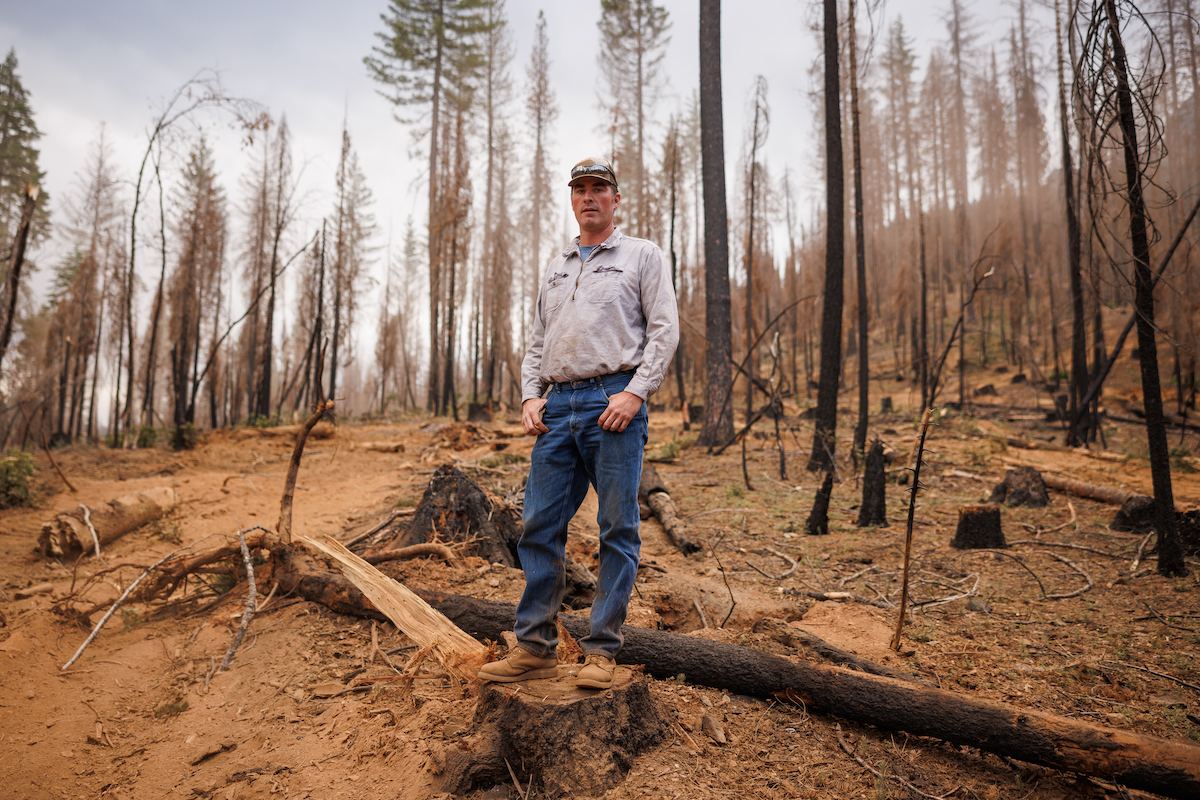
By early 2021, Pew had lined up 1,590 acres, including the Stouts’ forestland, to harvest and sell small trees to Sierra Pacific Industries. But with their sawmills overwhelmed by their own burned trees, the company owners decided not to buy these private landowners’ logs. The coup de grâce for Pew’s plans was the 2021 Dixie Fire, which all but demolished 12 of the 20 landowners’ forests, including the Stouts’.
As he contemplated his future in a valley choked with smoke, Pew doubted his business even had one. Greenville and three neighboring communities were razed to rubble. Residents, including some of his workers, had evacuated, their homes burned. Much of Indian Valley had no electricity, no telephones, and no internet. It was in this grim moment that Pew and Kusel looked ahead, weighed their odds, and resolved to build a sawmill. Kusel won permission to convert a $350,000 Sierra Nevada Conservancy grant, designated for a biomass boiler, to go toward saws and other equipment. Pew hauled his father, Randy, out of retirement, and J&C Lumber Inc. was born on the wood utilization campus in Indian Valley. Sierra Institute owns the sawmill; J&C Lumber runs the operations.
Randy Pew doesn’t bother with small talk before launching into discussion of the sawmill operation: “Most sawmills scrapped out a long time ago, so all I can say about this operation is it’s a beginning.”
A slender man wearing a baseball cap, blue work shirt, and pants held up by black suspenders, Pew strides from a circular saw spitting sawdust to a screaming band saw to a stack of freshly cut four-by-fours. All this equipment is flanked by decks of 33-foot logs stacked three stories high, awaiting their turn. “Every single one of those logs came from this valley,” Pew says.

A proud fifth-generation timberman, Randy Pew has been itching for a sawmill—“something! anything!”—since Caltrans began a massive post-Dixie roadside clear-cut designed to protect public safety. “When I saw them busting up trees 250 years old—just chipping them …” He pauses and takes a long breath, looking to the peaks beyond the lumberyard. “Something had to be done. They were wasting five to 15 houses a day in logs. Just wasting them,” he says.
His notion of buying new equipment quickly evaporated in the still-smoky air. “Forty years ago we could have picked this stuff up anywhere,” he says. “Not now.” So Pew went to work, plying the connections and the seat-of-the-pants savvy that accrue over generations. “Once I said ‘Dixie Fire’ everyone was willing to help.” It took 260 phone calls and six months of dogged determination to assemble the hodgepodge of blades, belts, and motors that most people simply call “Pew’s mill.”
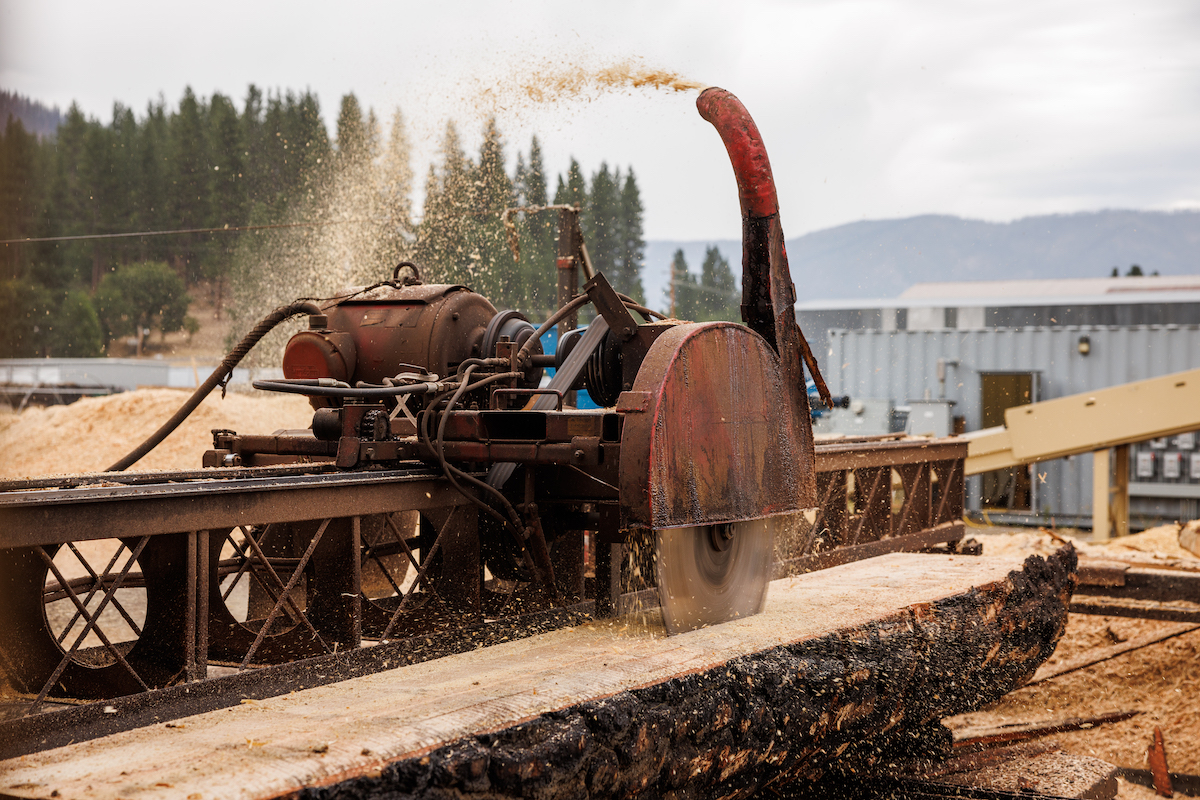
Pew has six workers now and will add a few more when he can find a planer. His goal is to cut 15,000 board feet a day. That’s three or four log-truck loads, extremely small potatoes compared to the Sierra Pacific mill output in Quincy. “They cut more in a few minutes than I can cut in a week,” Pew says. J&C Lumber is selling lumber to people rebuilding their homes lost in the Dixie Fire, often at below-market prices. “This operation is all about community,” he says.
Pew’s sawmill is that rare convergence of community grit and available capital, says Gentry, from the Forestry Association. “It would be great if we could replicate it,” he says. But the prospects of a nonprofit-owned or for-profit sawmill in every California town hit by fire are not promising. Adding round-the-clock shifts to existing operations is a possibility, but the $100 million cost of a new facility is formidable in today’s timber market, he said.
Faced with limited choices and funding, private forest owners like those in Indian Valley, continue to turn to their own ingenuity to deal with the material they want to thin from their forests. Some have built micro-mills they can haul around in pickup trucks. Others are developing cross-laminated timber from wood scraps.One entrepreneur has a proposal to turn wood slash into jet fuel. It’s all very small scale but exactly what’s needed, says Crowfoot, the state resources secretary: “The solutions are not created in Sacramento. They’re created in communities.”
Timothy Ingalsbee has been watching the gyrations of federal forest policy from Oregon, where he is executive director of Firefighters United for Safety, Ethics, and Ecology. In the 1980s, he was a self-described environmental activist who spent years protesting clear-cut logging of old-growth forests. Today, he says, small woodlot owners may have the best shot at establishing forests that can take the heat of fire and the dry of drought. Most are invested in their land for the long term and can plan to earn revenue from their forests through carbon storage as well as lumber. They have the incentive to think creatively about using wood, not only in harvest techniques but end uses: “making bigger things with smaller logs. Maybe even reviving logging as a craft skill,” Ingalsbee says.
The Stouts’ charred trees are still standing in their forest, where very few of the old ones survived. Their management goal is now restoration, including logging before the large trees rot and replanting species by species in a biological succession plan. Without active management the land will convert to brush, “a death knell for forests in this time of climate change,” says Moorea. As they walk home, their heartbreak is clear. But it’s spring, she says, and soon the tiger lilies will bloom. The Stouts know they won’t live to see mature stands on the hills beyond their house. Yet if government agencies follow the science, if the money allocated reaches the ground, if they keep thinking creatively, private landowners may have the chance to do their part toward making California forests more resilient. Despite the fire, the Stouts are committed. “We’re set on a path to bring back a forest again. I don’t know how much we will see,” Ted says, “but we know this land will recover.”
Support for this article was provided by the March Conservation Fund.


